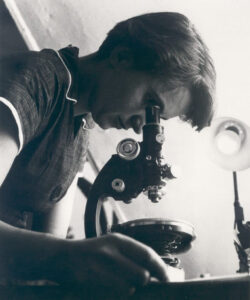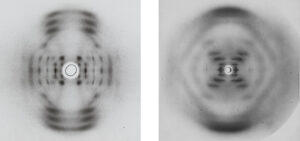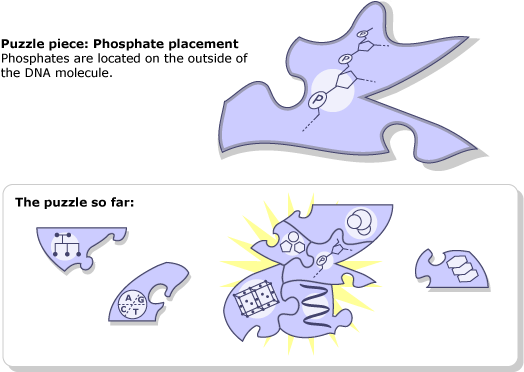
While Crick and Watson were joining forces at Cambridge, things were changing back in Wilkins’ lab at the University of London too. The preliminary findings were exciting — they knew that DNA had a regular structure — but they still had to figure out what that structure was. Expert help was needed to improve and interpret the X-ray results. Luckily, Rosalind Franklin, a scientist who specialized in X-ray diffraction, had just joined the lab. Franklin was used to working with messy materials that came from living things — she had just finished an important study applying X-ray diffraction to coal, the compressed remains of ancient swamp plants. She was asked to lend her expertise to the DNA project, and it soon caught her imagination.
Franklin began working with Raymond Gosling, the graduate student who had encouraged Wilkins to try X-ray diffraction on his DNA sample. Over the summer of 1951, she taught Gosling the exacting X-ray diffraction techniques she’d developed. They exposed the special high-quality DNA sample to a range of different humidities, from wet to dry. In the dry atmosphere, the strands appeared to thicken, and the X-ray patterns turned into a sharp scatter with many distinct spots. As they added moisture to the atmosphere, the strands stretched, and the X-ray pattern changed to a clear x shape.

The two different patterns demonstrated that DNA existed in two forms: the dry A form, which held less water, and the wet B form, in which water molecules cling to the DNA, causing it to stretch out. The first X-ray images of DNA taken by Wilkins and Gosling had been sharp, but they had contained a few confusing blurry spots. Franklin and Gosling’s new images explained why: the previous images were based on a blend of the two forms mixed together.

The University of London group had now uncovered several important clues to DNA’s structure: it was crystalline, at least one of its forms took the shape of a helix, and many water molecules could cling to it. Franklin took things one step further, fitting together a few of the existing puzzle pieces. Based on the ease with which DNA took up water, she reasoned that the phosphates (which attract water) must be on the outside of the helix. The London crew was off to a good start — but they would soon face stiff competition from another approach.

